#citation as a mourning ritual
Explore tagged Tumblr posts
Text
journaled (of a sort – was drafting a stressful conversation [not with anybody here or in person])
felt better after journaling
was surprised by how much better i felt
remembered that i always feel better after journaling + am subsequently surprised by it
recalled a moment roughly 3 1/2 years ago when my mentor was still alive & i was venting to him about the severe ableism i was experiencing in a different class (which he’d encouraged me to be as honest as i wanted about even though that professor was a close colleague)
he said he remembered me discussing during the program where we’d gotten to know each other 2 1/2 years prior how beneficial the assigned journals were for me, having a reason to take the time to organize & express my thoughts
i didn’t have to, of course, he said, but maybe i’d want to try journaling about it
6 notes
·
View notes
Note
Hello! I would like to ask if hyacinthus could be worshipped as a god? I saw a post saying that he could be a pre-Hellenic god.
Thank you :3
Khaire Anon,
Thank you for your question! I would like to start by saying this answer is LONG overdue, and that I apologize for the delay in my response.
As an introduction to this topic, any Ancient Greek mythical figure can be worshipped as a divinity if you feel inclined to do so. There are many examples of Hero Worship and Hero Cults throughout the ancient world and the modern-day; two examples are Penelope from The Odyssey and Ajax, son of King Telamon and Periboea (source: Wikipedia).
When speaking specifically of Hyacinthus; he is indeed an example of a mythic "hero" who was worshipped and honored in Hellenic Greece. While he was not viewed as a God in his role as Lord Apollo's consort, he was worshipped and honored alongside Lord Apollo - specifically in Sparta (source: Encylopedia Brittanica).
Outside of Hellenic Tradition, many scholars support the theory that Hyacinthus' worship predates the introduction of the Greek Pantheon in Corinth and Sparta.
"Hyacinthus was undoubtedly a pre-Hellenic god. [...] Certain aspects of his own cult suggest that he was an underworld vegetation deity whose death was mourned like that of Adonis." - Source: Encylopedia Brittanica
The Oxford Classical Dictionary states that Hyacinthus was a Dorian divinity whose cult was merged with Lord Apollo (source: Oxford Classical Dictionary). With him being associated with Dorians, Corinth, and Sparta - it would be good to learn more about Corinthian and Laconian history and worship practices (the worship calendar for Laconia and Sparta are often conflated as one and the same). This Wikipedia page provides a great jumping-off point if you want to learn more about the ritual calendars of non-Athenian Greek regions
The Wikipedia page for Hyacinthus states that:
"Hyacinthus personifies the sprouting vegetation in spring, which is killed by the heat of the summer. The apotheosis of Hyacinthus indicates that, after attaining godhood, he represented the natural cycle of decay and renewal."
The citations for these claims are from print sources that I am not able to verify at this time, but Encylopedia Brittanica and other sources seem to also support these claims so I feel comfortable providing the information.
So the short answer is, yes! Hyacinthus can be, and has been, worshipped as a God. He can be worshipped alongside Lord Apollo or separate from him.
For more information about Hyacinthus from a strictly Hellenic perspective, you can view his page on Theoi.com
If you have any additional or follow-up questions please don't hesitate to reach out!
Eirene - peace and farewell,
- Aön
#Ask#Answered Ask#the temple of hyacinthus#Hyacinthus#Hyacinth#Prince Hyacinthus#Lord Hyacinthus#HelPol#Hellenic Polytheism#textpost
16 notes
·
View notes
Text
Chapter 3: The History of Hie Shrine
The End of an Era
The priests of the Hie Shrine…none was more important to them than the Ninomiya kami, Kuni-no-Tokotachi. Kuni-no-Tokotachi was not only “the first kami of the universe,” he was venerated as the ancestral kami for priests of both Shōgenji and Juge lineages. In the 1830s… a disturbing discovery… indisputable evidence… Ninomiya kami was not in fact Kuni-no-Tokotachi… but an entirely different kami called Ōyamakui… the diffusion of new knowledge about the kami myths in the early nineteenth century. In medieval and early modern Japan, the ultimate textual authority on kami affairs… Nihon shoki… older Kojiki was much less known and used… changed in the early nineteenth century… publication of Motoori Norinaga’s Kojiki-den, and its citation in an increasing number of nativist works… The nativist Sugawara Natsukage also found inspiration in these Kojiki revelations in 1836, but his delight at learning the truth was complicated by bitterness. After all, was it not the case that the Tendai monks had deliberately concealed the truth of the Hie kami for a millennium and more?…short term, this revelation… seeems to have had no wider impact… longer term… it did.
These two unrelated developments, the revelation about the true nature of the Hie kami and the burgeoning proximity between Hie priests and the imperial court, enabled shrine priests like Shōgenji Kirestsu and Juge Shigekuni (1816-84) to imagine a future entirely divorced from the present… drew its inspiration from the remote past when Ōyamakui was venerated as the kami of Hie… priests were devoted uniquely to Ōyamakui and the imperial court… there could be no place for Tendai or any other form of Buddhism. After all, Buddhism had not existed in Japan when Ōyamakui was first venerated in Hie. Only a revolution coudl transform that Imagining into reality.
—Pages 106-108
The Hie Shrine and Modern Japan
The Meiji Revolution, 1868
…When they reached Sakamoto, they were joined by other priests and a gang of local peasants. Led by Juge… Hie’s seven shrines in turn… ripped out and then smashed burned, or stole anything that was Buddhist. A partial inventory of the treasures lost… a Śākyamuni statue; a bronze bell; 14 boxes containing the assembled Buddhist sutras and commentaries; the Prajñāpāramitā sutra in five boxes; the Lotus sutra in 10 volumes; golden Buddhist ritual implements; a statue of Dainichi (Mahāvairocana); and an altar used in a Buddhist fire rite (goma). All in all, more than 1,000 treasures were lost in the April frenzy at Hie (SBSa: 686-700).
—Pages 108-109
Truly horrifying knowing how much we lost due to the Meiji Restoration’s policies on Shinto and Buddhism, and mourning what could have been had such things not happened.
… the fledgling government had issued an edict ordering shrine priests across Japan to do precisely what Juge had done: remove all Buddhist statuary from their shrines… earlier edict banning Buddhist monks from serving the kami (Miyachi 1988: 425)… its purpose being to clarify what was of the kami and what of the Buddha; what was a shrine and what a temple; what, in short, was “Shinto” and what “Buddhism.” The stripping of shrines that went by the name of clarification impacted on Hie first, but it spread quickly the length and breadth of Japan… “Clarification” marked out new, exclusive time-spaces for shrines their kami, and their priests, separating off from temples, buddhas, and monks. Clarification laid the foundations for Shinto as we know it today, an autonomous religion, entirely distinct and independent form Buddhism (Breen 2000).
—Page 109
The most pressing task accorded the emperor was legitimizing the new regime and the coup that brought it into being. It was to this end… now invested in the imperial myth. The mythical narrative was a simple but arresting one: the sun-goddess established the imperial in mythical time; she dispatched her grandson Ninigi to earth to rule Japan on her behalf, and his descendant, Jinmu was then enthroned as the first human emperor. All subsequent emperors were direct descendants of Jingū and so of the sun-goddess.
This narrative was hardly new… However, the 1868 Restoration and the construction of the modern nation-state demanded it be made manifest and resonate throughout Japan… In 1869 the new Meiji emperor made his own historic pilgrimage to Ise…historic since no emperor had ever before worshiped there. ㊱ … visit transformed Ise from a popular pilgrimage site into the modern nation-state’s most sacred center, and it was critical too in animating the imperial myth… The imperial pilgrimage was preceded by a thorough stripping away of all Buddhist symbols from the shrine’s vicinity. Temples in Ise were either destroyed or screened from view; sutras were banned from sale. For Buddhism, far from clarifying the imperial narrative, offered a threateningly alternative view of history, in which Amaterasu was none other than the Sun Buddha and the emperors that Buddha incarnate. Clarification was imposed on all shrines in 1968 for the same reason. It as essential to the process of priming shrines in preparation for the articulation of the Imperial myth. Much other change was implicit in shrines’ new myth-bearing role.
—Pages 109-110
㊱ From the end notes: “As pointed out in Chapter 1, Empress Jitō did venture to Ise in 692, but it is now thought that her purpose was the survey the site on which the Ise shrines would be constructed (Tamura 1996: 181-5).
In 1871, the government banned the practice of hereditary succession at shrines, dispatching priests of its own choosing to the most important sites like Hie… same time, it declared all shrines to be “sites for the performance of state rites,” and a national shrine pyramid structured beneath Ise began to take shape (Miyachi 1988: 437). In 1873, the Meiji government laid down in law the annual cycle of rites which shrine priests were to perform… Where shrines in early modern Japan were defined by their diversity, uniformity would be the order of the day in Meiji.
—Pages 110-111
I do wonder just how much folk practice, and cultural lore was lost when the hereditary practices were banned.
0 notes
Note
curious as to what you have to say about the new lantern rite trailer .......

(other thoughts which were not articulated in this screenshot were "hey remember how the speculated reason for why they had three character banners during 1.3 was bc they didn't want to release hu tao, a funeral director, during lunar new year bc it would be bad luck?" and "of COURSE they finally decide to explore hu tao a bit more during this patch cycle, since death is inescapable in natlan thanks to the ode of resurrection")
dumping the rest under a cut lol
obvs VERY excited to learn more abt the rituals surrounding death and the afterlife in genshin bc um i <3 themes grief and mourning in fiction, but also bc it makes me curious abt what this will reflect abt the lore in natlan, esp since lunar new year (n thus lantern rite, by extension) falling in the later half of the patch suggests to me that they expect players to complete the natlan aq finale before experiencing this year's lantern rite.
hu tao is a character whose arc has always been very clear to me by nature of, like, an interest in gore and morbid things maturing into an interest in grief and death (which was very much helped along by that one college english class i took which was themed around the death industry and the ask a mortician youtube channel (which i had already been watching for like a year prior to taking that class. btw)), so i'm very keen on the serious expansion of her character and showcasing the part of her who does understand the weight of death and mourning and the roles these things play in our sense of humanity.
i've also been holding for a while now that natlan's true ideal is likely closer to that of "hope" than of "war" (and that the writers just kind of painted themselves into a corner n had to run with what they said earlier on), but the immolation of the main lantern in the trailer (seemingly as part of this year's lantern lighting ceremony) does also remind me of the fact that funerals do often have flames bc of like, funeral pyres and cremation. like, hu tao's pyro vision felt like it fell a lot more into place once we started exploring natlan n death became a part of the major story
and i don't think this conflicts with my assertion of "hope" being at the core of natlan, bc i think a clearer way of articulating myself would actually be that natlan structures its nation and its culture around "war", which at its center holds "hope" as its purpose (similar to how fontaine is the nation of "justice", but held an exploration of "truth" at the core of its story) and in turn allows for the exploration of other facets of war and conflict
though at the same time, positing that natlan revolves around hope (which keeps the sacred flame, That Thing Which Revives Characters After Death, alive n stuff) when you're only revived after battle if your team wins is kind of interesting to think abt when mulling over this intersection of hope and war, bc isn't the point of hope that it's able to keep going, to continue to produce miracles, even beyond the point of rationality, which is why you should never give up on it (citation: every classical magical girl show ever)? but at the same time, it is true that you can put too much faith and stock into something that was doomed to fail, and the culmination of that failure can shock you into losing hope for a while, or lead you to never attempt that again, even if the next time you encounter a situation like that, you're much more capable and prepared...
anyway this isn't so much abt lantern rite itself anymore as it is just abt the 5.3 version trailer but i do like that the final boss of natlan is just this giant fuckoff dragon with not one, but TWO swords, and also is just an impersonation made of darkness of the pyro sovereign, which would otherwise be the embodiment of fire (and therefore unavoidably light, to at least some extent). i'll have to poke around and review the lore surrounding the pyro sovereign in-game to make any real claims here, but the fact that the trailer has him talking abt using "the power of darkness" to "prove [our] efforts futile" and that "you [mavuika] have destroyed this world's hope with your own hands" is very cool very much looking forward to the contrasts btwn light and darkness, hope and despair (or should i perhaps say futility?) next patch. speaking of light and darkness, i do also remember the version livestream for enkanomiya release when the devs talked abt how they designed the area with the intent of exploring the contrasts btwn light and darkness in mind, but that's really digressing now lol
returning to the lantern rite thing, i also think that xiao would make for a good choice for one of the core characters in the plotline because of the fact that he also deals in death, he's been having this thing abt allowing himself to remember his dead comrades alongside his arc where he learns how to live... it's very fun to see this question of, "who are you still living for? the dead? or the living?" perhaps reflect on the turning point he had back in the chasm in the version story
and anyway, if lantern rite doesn't expand on all that shit through at least the very easy connection to the new year --> symbol of renewal and fresh starts, then i will be sad and perhaps send dawei ge a strongly worded letter.
#asks#anonymous#also lan yan is cute but since she's from chenyu i do sort of wish they localized her name to canto like w/gaaming#laam jin you will always be in my heart but also w/that said i hope she interacts w/cloud retainer#this reply is all over the place godbless
0 notes
Photo
[text: “Citation is a method of attachment. Through reference, we stitch ourselves into networks of thought.” end ID.]

Elizabeth Newton on how citations are, first and foremost, a method of attachment
9K notes
·
View notes
Note
You wouldn't happen to know what mourning rituals looked like in the Regency era would you? I'm trying to do some research but all I can find is how Queen Victoria influenced it later on.
This article is a decent rundown, though I dislike the lack of citations but it agrees with my actual historical notes and books: Mourning in the Regency Period
Now from Jane Austen's novels:
You will notice that the "action" of Sense & Sensibility begins half a year after Mr. Dashwood dies. This means the girls would be emerging from deep mourning and entering half-mourning. It is not until that time that Fanny worries that Elinor and Edward might get together. Those six months at Norland probably consisted of very little visiting beyond the family party.
Elizabeth Elliot decides to wear black ribbons for Mr. Elliot's wife, a person she has never met in Persuasion. She had a personal interest in him being a widow, but this shows that a person could decide to mourn for distant connections/family.
Also, both Mr. Elliot and Captain Benwick were in mourning when Anne meets them. Anne protests that Mr. Elliot could not think of her so soon after the death of his wife, but Lady Russell suspects he is: She [Lady Russell] was as much convinced of his meaning to gain Anne in time as of his deserving her, and was beginning to calculate the number of weeks which would free him from all the remaining restraints of widowhood, and leave him at liberty to exert his most open powers of pleasing.
This is also why Harville is so shaken by how quickly Captain Benwick moved on. Benwick only learned of his fiance's death in August, he proposes to Louisa sometime in December or January, which is just on the line of acceptable (about 6 months).
Also, in Emma, it would be disrespectful of Mrs. Churchill's memory to marry so soon after her death. This is why Frank and Jane wait until November to marry. Mrs. Churchill dies in July.
And here are some Regency mourning clothes:



If you notice the waistline dropping and/or the hem getting really fancy, then it's probably a gown from after Austen's lifetime. This is from 1819:

46 notes
·
View notes
Note
What’s their night time routine like? What’s their morning routine like? Is there anything they have to do before going to sleep or facing the day?
Do they have a favorite chore? Least favorite?
What is a smell that always brings up a memory for them, good or bad?
For the von Karma swordsman.
The von Karma swordsman is Markov. (Though, you know, his father Siegfried was actually more of a swordsman, and Markov's older brother Wolfgang also does the swords. But I get you, don't you worry.)
Markov doesn't have a "morning" and "night time" routine, because his sleep schedule is absolutely fucked up, and his frequent travelling between the timezones is only partially to blame.
He writes his articles whenever he has time, that includes some twenty minutes before going to sleep. So that's a thing for him: he has to write down several coherent sentences before he actually can fall asleep.
The day-starting rituals are far more easier to pin down, because they are more exact. It's getting his hair done and teeth brushed, his little beard maintained. He first checks his weaponage (usually it's a pocket switchblade, the sword-cane, and pepper spray) and only then he puts on his jacket, which is why you sometimes can catch him up just in shirt and trousers, because he's stuck sharpening something.
Markov doesn't do chores, because he stays at places where these sort of things are "outsourced" (hotels &c.), and as a young boy he lived in a household that had a few servants to take care of it. He could probably do laundry, because most manuals to washing machines are easy to look up, but he wouldn't be able to iron his own shirt. If you handed him a sponger, dish soap and pointed him to the sink, he'd scrub the sink and miss the dishes entirely. His "chores" are work related - keeping deadlines, providing citations and such. The one he hates the most is putting his notes (on paper, usually his cuffs, written in shorthand) into text (text document that he can send via email). On the other hand he likes editing after other people (he sometimes helps out a colleague here and there), because eliminating mistakes is one of his rare passions. He has a dedicated pen just for red ink.
The smell of steamed/boiled carrot mixed with scent of glued spruce wood always reminds him of the one time he went to take an interview with a married police couple: their new suburb house smelled (furnished by IKEA, carrot puree in the microwave), and the whole time he was there a small baby (about six months old) crying their little lungs our in the other room. When Markov's perfect nerves finally snapped and he asked the mother why doesn't she do something about the baby, he got the reply that "The kids have to learn from early on not cry for attention."
Well, no, that's not precise. What is Markov actually reminded of is the small article in the local print that he noticed by chance a week later with the heading "Family Mourning Baby Died In Parked Car" and unsurprisingly the family were the two policemen he had interviewed at their home. It's not a good memory. It's not a bad memory either. It's just a memory that makes him avoid meeting young couples in their new houses.
0 notes
Text
Imperative Reading for people that aren't sure if they have/had a valid customary marriage.
THE SUPREME COURT OF APPEAL OF SOUTH AFRICA
JUDGMENT
Not Reportable
Case no: 244/19
In the matter between:
ROBERT TSAMBO APPELLANT
and
LERATO RUBETA SENGADI RESPONDENT
In re:
TSAMBO, JABULANI DECEASED
Neutral citation: Tsambo v Sengadi (244/19) [2020] ZASCA 46 (30 April 2020)
Coram: MAYA P and MBHA, ZONDI and MOLEMELA JJA and MOJAPELO AJA
Heard: 6 March 2020
Delivered: This judgment was handed down electronically by circulation to the parties’ legal representatives by email, publication on the Supreme Court of Appeal website and release to SAFLII. The date and time for hand-down is deemed to be 12h00 on 30 April 2020.
Summary: Customary law – s 3(1)(b) of the Recognition of Customary Marriages Act 120 of 1998 – whether handing over of bride occurred – whether a valid customary marriage came into existence.
ORDER
On appeal from: Gauteng Division of the High Court, Johannesburg (Mokgoathleng J, sitting as a court of first instance): judgment reported sub nom Sengadi v Tsambo; In re: Tsambo [2018] ZAGPJHC 666; 2019 (4) SA 50 (GJ); [2019] 1 All SA 569 (GJ)
The appeal is dismissed with no order as to costs.
JUDGMENT
Molemela JA (Maya, P and Mbha and Zondi JJA and Mojapelo AJA concurring)
[1] The central issue in this appeal is whether on 28 February 2016 a customary law marriage came into existence between the deceased, Mr Jabulani Tsambo whose stage name was HHP (“Jabba”), and the respondent, Mrs Lerato Rubeta Sengadi. Ancillary to that issue is whether, pursuant to the conclusion of the lobola negotiations, a handing over of the bride ensued in satisfaction of the requirement that the marriage be negotiated and entered into or celebrated in accordance with customary law in terms of s 3(1)(b) of the Recognition of Customary Marriages Act 120 of 1998.
[2] The appeal is directed at the decision of the Gauteng Division of the High Court, Johannesburg (Mokgoathleng J), which found that a valid customary marriage was concluded between the respondent and the deceased. The appellant, Mr Robert Tsambo, is the biological father of the deceased.
[3] In support of relief she sought from the high court, the respondent relied on the following facts. The deceased proposed marriage to her on 6 November 2015 in Amsterdam. She immediately accepted the marriage proposal. The deceased considered African culture to be important and insisted that the couple conclude a marriage in terms of customary law[1] with the blessings of their respective parents. The respondent agreed. On 20 January 2016 the appellant dispatched a letter written by the deceased’s uncle, Mr Tutu Mokgatle, to the respondent’s mother. The letter requested that the families of the respondent and the deceased meet ‘to discuss the union’ of the deceased and the respondent. On 28 February 2016 the two families met at the respondent’s family home. Although the appellant and the respondent’s mother were present at the respondent’s home, they did not participate in the lobola negotiations, as is the custom. Upon the successful conclusion of the lobola negotiations, a lobola agreement was concluded, reduced to writing and signed. It stipulated that the lobola agreed upon was an amount of R45 000. It further recorded that the deceased would pay a deposit of R30 000 upon signature of the agreement and that the balance would be paid in two instalments. As a postscript to the agreement, it was recorded that ‘the final amount at our next meeting shall be R10 000. It is agreed that the remaining R5000 will follow at some later stage.’
[4] At the conclusion of the lobola negotiations, the women from the respective families attended to the preparation of a meal. At this time, the deceased left the respondent’s home for a short while. In the intervening period, the respondent’s mother received a payment notification on her phone, advising that the deceased had transferred an amount of R35 000 into her bank account.
[5] When the deceased returned, the respondent noticed that he had changed into formal attire. She also noticed that the deceased's aunts, Ms Nomvula and Ms Minky, had emerged from outside and entered the house bearing a covered outfit on a clothes hanger. The deceased's aunts requested the respondent to accompany them into one of the bedrooms. Once in the bedroom, the deceased’s aunts revealed an outfit from the clothes hanger, and informed her that the attire was her wedding dress. They then proceeded to dress her up in that attire. When she emerged from the bedroom, she noticed that her attire matched the deceased’s. She then realised that not only was that day reserved for lobola negotiations, but the deceased and his family had also planned that a customary law marriage between her and the deceased should be celebrated on the same day. The deceased’s aunts introduced the respondent to all persons present as the deceased’s wife and thereafter welcomed her to the Tsambo family. The appellant approached the respondent, embraced her and congratulated her on her marriage to the deceased.
[6] The celebration that ensued after the lobola negotiations was recorded on video camera by one of the attendees. Photographs described as screenshots were obtained from the recording and introduced into evidence. In one of the photographs, the appellant is depicted with the deceased and the respondent, who are dressed in matching attire. In another, the appellant can be seen embracing the respondent. The video recording was introduced into evidence and viewed at the high court. The high court recorded that the video depicted the two families in a joyous celebratory mood ululating and uttering the words ‘finally, finally’. The respondent averred that a lawful customary marriage came into existence between the deceased and herself on that day. She asserted that later that day when she and the deceased returned to their place of abode, they did so as husband and wife. Consequently, their place of abode became the matrimonial home, so she asserted. It is common cause that the customary marriage was not registered with the Department of Home Affairs.
[7] According to the respondent, she and the deceased continued to live together as husband and wife until sometime during 2018, when their relationship went through a rough patch, apparently because of the deceased’s infidelity and drug addiction for which he refused to undergo rehabilitation. This caused the respondent to leave the matrimonial home although she did not take all her personal belongings with her. Due to the deteriorating health and depression of the deceased, during April 2018, the respondent convened a meeting of the two families. She reported the deterioration in the deceased’s health. The deceased, however, stalked out in a huff before any resolution could be reached. During August 2018, the couple reconciled but did not resume their cohabitation as the respondent had insisted that she would return to the matrimonial home only if the deceased agreed to submit himself to a rehabilitation programme. Unfortunately, the deceased committed suicide on 23 October 2018. The respondent returned to the matrimonial home on 24 October 2018 in order to mourn the passing of her husband. On 27 October 2018, the appellant informed the respondent that he did not acknowledge her as the deceased’s wife and barred her from making funeral arrangements for him. He subsequently changed the locks of the matrimonial home, thereby depriving the respondent of access thereto.
[8] The respondent launched an urgent application, essentially seeking recognition of what she asserted to be a customary marriage between her and the deceased and all rights consequent upon that marriage. The salient orders sought in terms of the notice of motion were couched as follows:
‘2. It is declared that the customary marriage between [the respondent] and the deceased is a customary marriage entered into validly on 28 February 2016, and as envisaged in terms of section 3 of the Recognition of Customary Marriages Act, 120 of 1998.
3. The [respondent] is declared to be the lawful customary wife of the deceased . . . who died on the 23rd of October 2018.’
The rest of the relief sought in terms of the notice of motion is not the subject of the appeal before us and need not detain us.
[9] The appellant opposed the application. The main thrust of his opposition was that the respondent had no right to the relief sought, as no customary law marriage had been concluded between her and the deceased on 28 February 2016. The appellant argued that ‘at best for the deceased, the necessary customs, rituals and procedures required for the conclusion of a customary marriage may have commenced, but were not proceeded with or completed.’ The appellant averred that the meeting that took place on 28 February 2016 was confined to lobola negotiations and what happened thereafter merely constituted a celebration of the successful conclusion of the lobola negotiations. He asserted that it was clear from the terms of the lobola agreement that the families intended to have a further meeting thereafter.
[10] The appellant also averred that ‘[t]he two families would have [had] to agree on the formalities and the date on which the [respondent] would be “handed over” to the [deceased’s] family’. He contended that in terms of custom, subsequent to the initial payment of lobola, a date is set on which the bride’s family will hand over the bride to the husband’s family, ‘go gorosiwa’,[2] and upon arrival a lamb or goat is slaughtered and the bile therefrom is used to cleanse the couple. He contended that the performance of that ritual would signify the union of the couple and the joining of the two families. That ritual would be followed by a celebration, during which the lamb or goat that was slaughtered would be consumed. The appellant contended that because that ritual was not observed, the handing over of the bride, which he considered as the most crucial part of a customary marriage, did not take place.[3] Thus, so it was contended, no customary marriage came into existence between the deceased and the respondent.
[11] The high court found that the handing over was not a strict requirement for a valid customary marriage and could be waived. It found that there was a tacit waiver of the custom of the handing over of the bride because a symbolic handing over of the respondent to the deceased’s family had occurred after the conclusion of the customary marriage. It rejected the appellant’s contention that the most crucial part of a customary marriage is the handing over of the bride and that the absence thereof would result in no valid customary marriage coming into existence. The high court, inter alia, granted the following orders:
‘1. It is declared that the customary marriage between the [respondent] and the deceased is a customary marriage entered into validly on [the] 28th February 2016, and as envisaged in terms of Section 3 of the Recognition of Customary Marriages Act, 120 of 1998.
2. The [respondent] is declared to be the lawful customary wife of the deceased, JABULANI TSAMBO . . . who died on the 23rd of October 2018.’
[12] Before us, it was contended on behalf of the respondent that the requirement of handing over of the bride is not determinative of a customary marriage. As authority for that proposition, the respondent relied on the writings of Professor Bennett and Professor Bekker with specific regard to the evolution of the customary marriage practices of the Batswana people, which is the customary law that is applicable in the present case. Professor Bekker[4] in Seymour's Customary Law in Southern Africa, argued that amongst the Sotho-Tswana people, the wedding is celebrated at the bride’s family home, where the lobola negotiations take place. In some of the communities, the handing over of the bride takes a physical form on the day of the wedding.[5] Professor Bekker proceeds to observe as follows:
‘On the completion of the lobolo agreement, the bride's guardian provides a beast for slaughter, each party receiving half the meat; certain ceremonies are performed with the entrails. This slaughter signifies not only the completion of the lobolo agreement, but also the consummation of the customary marriage, which is not rendered less effective if the bride does not leave with the bridegroom's party on that occasion, and usually she does not.’[6]
[13] It is clear from the preceding discussion that historically, significance was paid to the conclusion of the lobola agreement, and not necessarily the full payment of lobola. Therefore, the appellant’s contention that a marriage could not have been concluded as it was agreed that part of the outstanding balance on the lobola would be paid ‘at the next meeting’ is devoid of any merit. In my view, it simply does not follow that the completion of the customary marriage process on the same day was precluded because it was not pertinently discussed during the negotiations. As mentioned above, the crisp question in this matter is whether, on the facts of this case a customary marriage came into existence.[7] The handing over of the bride is an issue that was raised by the appellant as proof that the existence of a customary marriage had not been established. The facts must be considered against the backdrop of relevant authorities.
[14] Section 3(1) of the Recognition of Customary Marriages Act provides:
‘For a customary marriage entered into after the commencement of this Act to be valid –
(a) the prospective spouses –
(i) must both be above the age of 18 years; and
(ii) must both consent to be married to each other under customary law; and
(b) the marriage must be negotiated and entered into or celebrated in accordance with customary law.’
[15] When dealing with customary law, it should always be borne in mind that it is a dynamic system of law.[8] In Ngwenyama v Mayelane and Another[9] this Court stated as follows:
‘The Recognition Act does not specify the requirements for the celebration of a customary marriage. In this way, the legislature purposefully defers to the living customary law. Put differently, this requirement is fulfilled when the customary law celebrations are generally in accordance with the customs applicable in those particular circumstances. But once the three requirements have been fulfilled, a customary marriage, whether monogamous or polygamous, comes into existence.’ (Own emphasis.)
[16] In Mabuza v Mbatha[10] the court, stated that there was no doubt that the custom of ukumekeza[11] had evolved so much so that it is probably practised differently than it was centuries ago. It went on to endorse the view that it was inconceivable that ukumekeza had not evolved and that it could not be waived by agreement between the parties and/or their families in appropriate cases.[12] That dictum was approved by this Court in Mbungela and Another v Mkabi and Others.[13] Having reviewed several authorities, this Court concluded that the handing over of the bride, though important, is not a key determinant of a valid customary marriage. It aptly stated as follows:
‘The importance of the observance of traditional customs and usages that constitute and define the provenance of African culture cannot be understated. Neither can the value of the custom of bridal transfer be denied. But it must also be recognised that an inflexible rule that there is no valid customary marriage if just this one ritual has not been observed, even if the other requirements of s 3(1) of the Act, especially spousal consent, have been met, in circumstances such as the present ones, could yield untenable results.’
[17] The appellant’s contentions pertaining to the rituals observed during the handing over of the bride ceremony fail to take into account that customary law is by its nature, a constantly evolving system.[14] That customary law has always evolved is evident from the following observation made by Professor Bennett almost three decades ago and approved in many judgments:
‘In contrast, customary law was always flexible and pragmatic. Strict adherence to ritual formulae was never absolutely essential in close-knit, rural communities, where certainty was neither a necessity nor a value. So, for instance, the ceremony to celebrate a man’s second marriage would normally be simplified; similarly, the wedding might be abbreviated by reason of poverty or the need to expedite matters. Aside from this, the indigenous rituals might be supplanted by exotic ones: a wedding ring may now be used in place of the traditional gall bladder of a slaughtered beast and for many a church ceremony has become indispensable.’[15]
[18] It is evident from the foregoing passage that strict compliance with rituals has, in the past, been waived. The authorities cited by the respondent, mentioned earlier in the judgment, also attest to that. Clearly, customs have never been static. They develop and change along with the society in which they are practised.[16] Given the obligation imposed on the courts to give effect to the principle of living customary law,[17] it follows ineluctably that the failure to strictly comply with all rituals and ceremonies that were historically observed cannot invalidate a marriage that has otherwise been negotiated, concluded or celebrated in accordance with customary law.
[19] Before analysing the facts of this case, it is appropriate to address the appellant’s contention that there was a dispute of fact pertaining to the question whether the events of 28 February 2016 established a customary marriage. The appellant submitted that in the light of a material factual dispute regarding the nature of the celebrations after the conclusion of the lobola negotiations, the high court ought to have referred the dispute to trial or for the hearing of oral evidence in accordance with the principle established in Plascon-Evans Paints Ltd v Van Riebeeck Paints (Pty) Ltd.[18] A brief consideration of the Plascon-Evans rule is required. The principle laid down in that seminal judgment is that an applicant who seeks final relief using motion proceedings must, in the event of a dispute of fact, accept the version set up by his or her opponent unless the latter’s allegations are, in the opinion of the court, not such as to raise a real, genuine or bona fide dispute of fact or are so far-fetched or clearly untenable that the court is justified in rejecting them merely on the papers. The nub of the issue is whether on the facts, and bearing in mind the Plascon-Evans rule, the handing over of the bride was established.
[20] In Wightman t/a J W Construction v Headfour (Pty) Ltd and Another,[19] this Court clarified the effect of factual disputes in motion proceedings as follows:
‘A real, genuine and bona fide dispute of fact can exist only where the court is satisfied that the party who purports to raise the dispute has in his affidavit seriously and unambiguously addressed the fact said to be disputed. There will of course be instances where a bare denial meets the requirement because there is no other way open to the disputing party and nothing more can therefore be expected of him. But even that may not be sufficient if the fact averred lies purely within the knowledge of the averring party and no basis is laid for disputing the veracity or accuracy of the averment. When the facts averred are such that the disputing party must necessarily possess knowledge of them and be able to provide an answer (or countervailing evidence) if they be not true or accurate but, instead of doing so, rests his case on a bare or ambiguous denial the court will generally have difficulty in finding that the test is satisfied. I say “generally” because factual averments seldom stand apart from a broader matrix of circumstances all of which needs to be borne in mind when arriving at a decision. A litigant may not necessarily recognise or understand the nuances of a bare or general denial as against a real attempt to grapple with all relevant factual allegations made by the other party. But when he signs the answering affidavit, he commits himself to its contents, inadequate as they may be, and will only in exceptional circumstances be permitted to disavow them. There is thus a serious duty imposed upon a legal adviser who settles an answering affidavit to ascertain and engage with facts which his client disputes and to reflect such disputes fully and accurately in the answering affidavit. If that does not happen it should come as no surprise that the court takes a robust view of the matter.’
[21] It is evident from the foregoing passage that a bona fide dispute of fact only arises when the party raising it seriously addresses the facts that are disputed, especially where the disputing party is in a position to be aware of the facts. The difficulty for the appellant in this matter is that he provided no answer to some of the respondent’s crucial allegations. He did not engage with the respondent’s assertions pertaining to specific events that were said to have happened in his presence, such as her being dressed in a wedding attire as described by the deceased’s aunts, being introduced to the witnesses by them as the deceased’s wife and welcomed to his family and being congratulated by the appellant on the marriage. These allegations were not gainsaid despite the fact that they related to aspects that lay within his personal knowledge and for which he could provide an answer.
[22] There was a bare denial regarding the material aspect of what the change of clothes and the words uttered signified. Whereas the respondent supported her evidence with the confirmatory affidavits of her relatives who were present during the lobola negotiations, the appellant did not support his bare denials with any confirmatory affidavit. I find it odd that the deceased’s aunts, who played a crucial role in the events, did not depose to any affidavit. One of the aunts, Ms Nomvula, was reportedly present at the deceased’s house before his burial. This was not denied by the appellant. Surprisingly, not even an unsworn statement was presented as her account of events. Instead, an unsworn statement, allegedly authored at the instance of the deceased’s mother after the deceased’s death, was attached to the appellant’s papers. While it is trite that hearsay evidence may be admitted in urgent applications, the note prepared by the deceased’s mother cannot carry much weight as she was not part of the lobola negotiations and the celebrations that followed.
[23] Notably, no reason was given for not obtaining affidavits from those who were present. In my view, the same effort expended to procure an unsworn statement from the deceased’s mother could have been spent on obtaining a statement from Ms Nomvula. The very fact that the appellant was able to procure a statement from the deceased’s mother actually puts paid to the appellant’s contention that he was not provided with sufficient opportunity to interrogate the factual disputes. When all is said and done, the appellant’s bald denials did not create a bona fide dispute of fact necessitating the referral of the matter for oral evidence or trial, or even the dismissal of the application.
[24] The appellant contended that the fact that both the respondent and the deceased considered culture to be of significance cast doubt on whether they could have intended to conclude a wedding without observing such a crucial aspect of their culture like the handing over of the bride. I disagree. In my view, there is sufficient undisputed evidence from which it can be inferred that the deceased, a successful musician who had a busy schedule,[20] had decided to expedite the conclusion of the customary marriage. The letter requesting a meeting for the lobola negotiations was dispatched relatively soon after he had proposed marriage to the respondent. After the conclusion of the lobola negotiations, the deceased transferred more than the amount he was required to pay as a deposit for the lobola. It is also significant that the deceased and the appellant were in attendance at the respondent’s home even though the family had nominated emissaries that would represent him during the lobola negotiations.
[25] While rituals associated with the handing over of the bride, like the slaughtering of the sheep and the consumption of its bile were indeed not observed, there are some features that bear consideration. It is quite striking that the deceased’s aunts are the ones who provided the respondent with an attire matching that of the deceased and who actually dressed her up in it. That they described it as her wedding dress is quite telling. These are customary practices that are undoubtedly compatible with an acceptance of the respondent by the deceased’s family.
[26] The clearest indication of her acceptance as the deceased’s wife is evidenced by the actual utterances that were made: the respondent was formally introduced as the deceased’s wife and welcomed to the Tsambo family. Thereafter, the appellant embraced her and congratulated her on her marriage to the deceased. Bearing in mind that thepurpose of the ceremony of the handing over of a bride is simply to mark the beginning of a couple’s customary marriage and introduce the bride to the bridegroom’s family,[21] I am inclined to agree with the respondent’s assertion that a handing over, in the form of a declared acceptance of her as a makoti (daughter-in-law), satisfied the requirement of the handing over of the bride.
[27] That the couple continued to cohabit after that celebration and that the respondent registered the deceased as a beneficiary and spouse on her medical aid scheme[22]are features that cannot be dismissed as insignificant, as they are consonant with the existence of a marriage. I am fortified in this view by Professor Bennet’s argument with regards to the handing over requirement. He argued that the parties’ intention could be inferred from cohabitation. According to him, where the parties were cohabiting, the gravamen of the enquiry was the attitude of the woman’s guardian. If the guardian did not object to the relationship, a marriage would be presumed, irrespective of where the matrimonial home happened to be or how the ‘spouses’ came to be living there.[23] Professor Bennett placed reliance on a case in which the Court had remarked that “long cohabitation raises a strong suspicion of marriage, especially when the woman’s father has taken no steps indicating that he does not so regard it”.[24] In this matter, the respondent averred that her mother had not instituted any action for seduction or demanded payment of a fine, well knowing that the respondent cohabited with the deceased. She accepted that the respondent and the deceased had entered into a valid customary marriage.
[28] To sum up: the respondent’s evidence of the events that took place on the day of the lobola negotiations is supported by several confirmatory affidavits. The appellant’s bare denials did not refute the respondent’s evidence. Clearly, the correct application of the Plascon-Evans rule did not preclude the high court from granting final relief on the papers, where the evidence put up by the appellant did not constitute a bona fide factual dispute.
[29] Despite the high court’s misgivings about the application of the Plascon-Evans rule in the context of an urgent application, it is evident that, in reality, it applied the same rule and came to the correct decision regarding the waiver of some of the rituals associated with the handing over of the bride. It is therefore not necessary to determine whether a more robust approach was necessary. To the extent that the high court stated that the Plascon-Evans rule was not satisfactory in the context of urgent applications, it erred.
[30] Having considered all the facts and circumstances of this case, I am persuaded that on 28 February 2016, the respondent and the deceased concluded a customary marriage that complied with all the requirements for a valid customary marriage as contemplated in s 3(1) of the Act. It follows that the appeal against that order of the high court must fail.
[31] Despite the finding that the appeal against the order of the high court ought to fail, there is an aspect that this Court is constrained to pronounce itself on. Having correctly found on the facts of this case that the physical handing over of the bride was waived in favour of a symbolic handing over, the high court, in the process of giving reasons for its order, proceeded to declare that the custom of the handing over of the bride was unconstitutional.
[32] In Director of Public Prosecutions, Transvaal v Minister for Justice and Constitutional Development and Others,[25] the Constitutional Court laid down that a court may raise, of its own accord, the unconstitutionality of a law that it is called upon to enforce.[26] It pointed out that it may do so where (a) the constitutional question arises on the facts; and (b) a decision on the constitutional question is necessary for a proper determination of the case before it or it is in the interests of justice to do so.[27] It pointed out that it was neither necessary nor desirable to catalogue circumstances in which it would be in the interests of justice for a court to raise, of its own accord, a constitutional issue, because that would depend on the facts and circumstances of the case.[28] It stressed that the parties must be afforded an adequate opportunity to deal with the issue.[29]
[33] It must be borne in mind that it was never the respondent’s case that the requirement of the handing over of the bride was unconstitutional. The issue of the handing over of the bride became relevant in so far as establishing whether a customary law marriage came into existence. Given the pleaded case, a decision on the constitutionality of the custom of the handing over of the bride simply did not arise. During the exchange with the bench, both counsel assured this Court that the constitutionality issue was not canvassed during argument before the high court. They bemoaned the fact that the declaration was made without the benefit of full argument. Since prerequisites laid down by the Constitutional Court in the afore-mentioned judgment have not been met, I am inclined to agree that there was no basis for the high court to declare that the handing over custom was unconstitutional.
[34] With regard to costs, counsel for the appellant informed us that he was representing the appellant on a pro bono basis. He submitted that if this Court was inclined to find against the appellant, it should grant an order in terms of which the costs of the appeal are borne by the deceased estate, as the appellant was cited in his personal capacity as well as in his capacity as the head of the Tsambo family. The respondent’s counsel indicated that it left the issue of costs in the Court’s discretion. All things considered, it would be appropriate not to make any order as to costs.
[35] The appeal is dismissed with no order as to costs.
0 notes
Text
1. Allen Ginsberg, Castiel, and Buddhism: the similarities between Ginsberg and Cas
In THIS POST I discussed the links between the famous Beat literature novel On The Road and how Sal Paradise (Jack Kerouac) and Dean Moriarty (Neal Cassady) were inspirations for Sam and Dean, and that Neal Cassady was very similar to Dean Winchester. So Kerouac and Cassady were huge figures within the beat generation, however another key figure was Allen Ginsberg. At the end of that post I discussed the on-off sexual relationship between Neal Cassady and Ginsberg which I will continue to discuss here. In this post I am going to discuss how Ginsberg can be linked to Cas and what this means.
I am going to split these series of metas/discussions into a few parts. This one will be about Cas and Ginsberg. I will then go on to discuss Cas and Buddhism in another post. And then will narrow down into discussions of Buddhist theology and its links to Cas’s arc. This first post will have to be rather general. Allen Ginsberg has been my main research focus for 6 years and I have spent the past 4 years studying Buddhism. It would bore you if I made these posts ridiculously detailed, so I will just be fairly general. If anyone would like to know more, ask more specific questions, get reading lists, or ask me to back up my assertions with sources then I am more than happy to do so. But seeing as this is tumblr and I won’t be submitting this to an academic institution, my citations will be few and far between.
Irwin Allen Ginsberg was a 20th Century American poet, born in 1926 and died in April 1997. He was a leading figure of the beat generation of writers who were most prominent in the late 1950s and early 1960s. The Beat Generation of writers include Jack Kerouac (who wrote On The Road), Neal Cassady, William Burroughs (who wrote Naked Lunch), Allen Ginsberg, and others including Gregory Corso, Gary Snyder, Diane DiPrima, Michael McClure (side note, I once met Diane DiPrima and Michael McClure and I don’t think I’ve ever gotten over that. It was amazing. I talked to McClure about when he shouted poetry at some lions. I digress). Ginsberg’s most famous peom is Howl which became infamous after it was banned due to it being too crude and so there was a huge obscenity trail which Ginsberg won in the end. Ginsberg was gay and fell in love with Neal Cassady (who is Dean Moriarty in On The Road). Ginsberg was brought up Jewish but became a Buddhist in the 1950s. He was a founding father of the countercultural movement and the hippie generation. He was esoteric in his views on spirituality.
Ginsberg met Kerouac and Burroughs during his studying at Columbia University in NY. Neal Cassady rolled into town and they all became great friends. In comparison to Jack Kerouac and Neal Cassady, Ginsberg was more nerdy, bookish, quiet, reserved. Whilst Jack and Neal looked like jocks, Ginsberg with his glasses and dark brown hair and non-sports physique was very different.
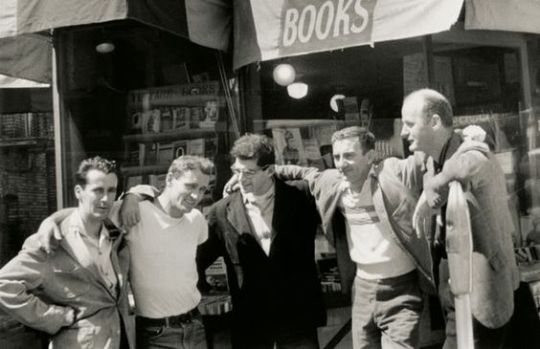
(Neal is 2nd to left in white t-shirt, Allen is next to him)
In Supernatural, Sam and Dean are the original protagonists and Cas comes along later and is not the classic All-Amerian jock-looking male protagonist. Like Allen, he is less stereotypically masculine. An interesting thing to note about his introduction is that from the outset it is not specifically Christian. Whilst Dean and Bobby find out at the end of the episode that he is an angel, they first cover the barn in symbols from many different faiths. Whilst this might be a reach, from what we see from Cas as the seasons progress, he has never been spiritual purely in a Judeo-Christian way. Rather, he is introduced in a set covered in symbols from many faiths and then throughout the seasons he is linked to Buddhism and general multi-faith esotericism and humanism. His growing distance from stance Christian/Angel dogma shows that his faith has always been more esoteric and less dogmatic than the other angels. Ginsberg was a man who combined many different faiths. He was brought up Jewish but from the late 1950s onwards he turned to buddhism and also had an interest in Christianity (notably Gnostic Christianity). One of Ginsberg’s (arguably best) poems is Kaddish and uses the Jewish mourning ritual prayers as it’s structure. Whilst it is easy to think of Angels as being Christian, much of the great spiritual texts which discuss angels (including most of the ones detailed in Supernatural) were in ancient Judaic texts such as The Book of Enoch and texts which are Judaic but are also shared within The Old Testament.
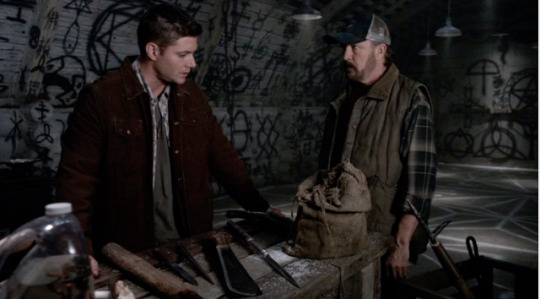
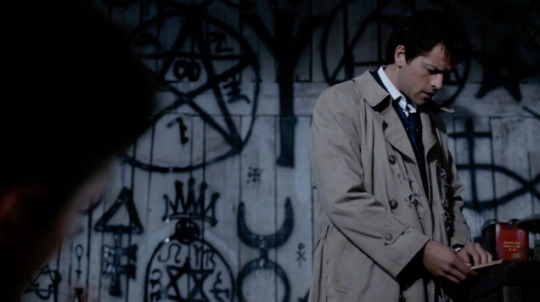
Cas also heads towards Dean’s book and immediately looks through it. So he is also being set up as an intelligent/bookish being. Like Ginsberg in the 40s and 50s, he is dressed in rather smart clothes that contrast against the rugged styles of Sam and Dean. He seems like an outsider to their group, like Ginsberg.

Ginsberg watched and listened in many situations, and when he met Jack and Neal and Burroughs at Columbia he was almost entranced by these people and found them alluring. Cas is also like this in some respects, in that he is intrigued by Sam and especially Dean (however I am not saying this to disregard the agency of either Cas or Ginsberg). Ginsberg also spent much of his life helping his close friends. He was the one who managed to get On The Road by Kerouac and Naked Lunch by Burroughs published. Ginsberg worked tirelessly as their free publishing agent in order to help them and would continuously send them money if they were in need of it. Ginsberg’s long-time partner, Peter Orlovsky had many struggles and Ginsberg dedicated much of his time to helping him. Both Cas and Ginsberg go to extraordinary lengths in order to help those close to them with costs them both. For Cas, he leaves heaven, is cut off from his family, and goes through huge struggles in order to help Sam and Dean. For Ginsberg, he lost huge amounts of money, had drug addict friends steal from him, his health declined due to spending too much energy helping those around him.
I will now discuss the links between Ginsberg and Cas which are apparent most notably in The End. The episodes of most relevance to my broader discussion of Ginsberg, Cas, and Buddhism are the episodes that include endverse!Cas, crazy!cas, homeless!cas, and Emmanuel. In these instances, I find Cas to be more human, or at least less angel. When Cas diverts further from being an Angel then these similarities come to light. I think that who Cas really is is stifled by the strict rules and laws of the angels, and when he is most free from these we see not necessarily his humanity (though of course we see this), but who he is as a real individual. Of course, we see the similarities between these versions of Cas and humanity, but it is important to note that we see him as an angelic being who is also an individual, and his individuality and his choices become concretised when he is furthest from angel laws and rules. Being a human is all about choice, and we know who we are by the choices we make. But we know who we are as an individual by the choices we make, so when Cas has the freedom to make his own choices then we see him as a true individual, or at least as a condensed version of his individual thoughts and ideas.
The End (5.04)
In this episode, Cas is first seen in a large bedroom full with buddhist iconography with Eastern music playing. There is a close up shot of a statue of The Buddha, so this is obviously important to note within this episode.
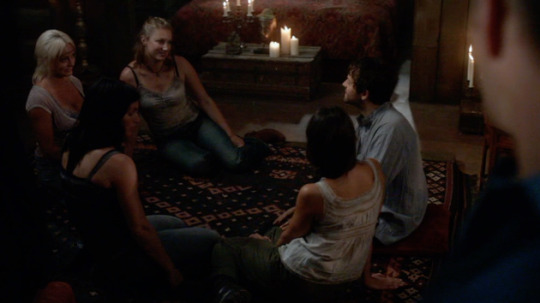
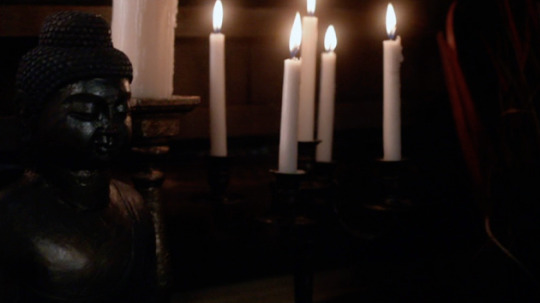
But with regards to this discussion of Cas and Ginsberg, the importance isn’t just that Cas is surrounded by Buddhist symbols. This specific relevance to Buddhism I will go into later when I discuss Buddhism and Cas. But let’s stick to why this episode is important with regards to the links between Cas and Ginsberg. Since the late 1950s, Buddhism had become an important part of Ginsberg’s spiritual and literary life. He took his Buddhist vows in 1972 and continued to practise meditation until his death (although his views on spirituality weren’t confined to Buddhism as he grew up Jewish and mixed Judaism with Gnostic Christianity into the mix of his own spirituality – he referenced his personal multi-theology during interviews shortly before his death where he said that, as Whitman says he contains multitudes. Both Josh Pederson and Stephen Prothero argue that Ginsberg and the Beats were not constrained to one religious doctrine, although Prothero does note that Buddhism ‘did inspire more of them more deeply than any other. (Stephen Prothero, On The Holy Road: The Beat Movement as Spiritual Protest (217)). Ginsberg was of great importance in bringing Buddhism into the mainstream in the 1960s. Ginsberg was a forefather of the hippies, and this point cannot be understated. The beats and their spontaneous prose, their drinking, their drugs, their sex, their freewheeling lifestyle were the precursor to the hippie generation, but if one person from the beat generation was most important to the hippies of the 1960s, it was Ginsberg. Anyone who was of any importance in the 1960s countercultural hippie movement in America knew Ginsberg. Ginsberg was the ‘prototype hippie’ (Peter Conners, White Hand Society: The Psychedelic Partnership of Timothy Leary & Allen Ginsberg, 200). Ginsberg was highly active within the protest movements of the 1960s. He was an advocate for LSD and along with Timothy Leary, they were the people who brought LSD into the mainstream. Ginsberg was also an advocate of free sexual attitudes and took part in orgies. Many of the ogies he was involved in were tantric, and combined sex with Buddhist teachings in order to use sex to open people’s consciousness’s and join them together with everyone else (I remember a particular incidence when this happened on a trip with the poet Gary Snyder). Ginsberg took a great deal of drugs. His first drug experience was at the dentists when he took nitrous oxide, and then he started to smok pot with his fellow beats, then took benzadrine, amphetamines, mushrooms, LSD (he was one of the people to take it before it was a popular drug in the 60s and then after taking it turned major musicians on to the drug and wrote about it, and gave speeches about why people should take it in order to expand the consciousness. If anyone is interested, the poem Wales Visitation was written whilst he was on acid and I highly recommend it), and he also drank a lot. He was a huge advocate for weed and spent tireless hours building a case about why it should be legal.
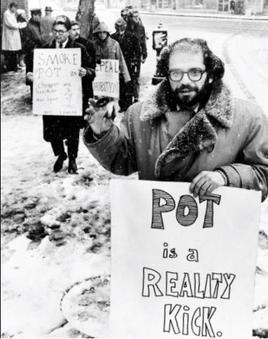
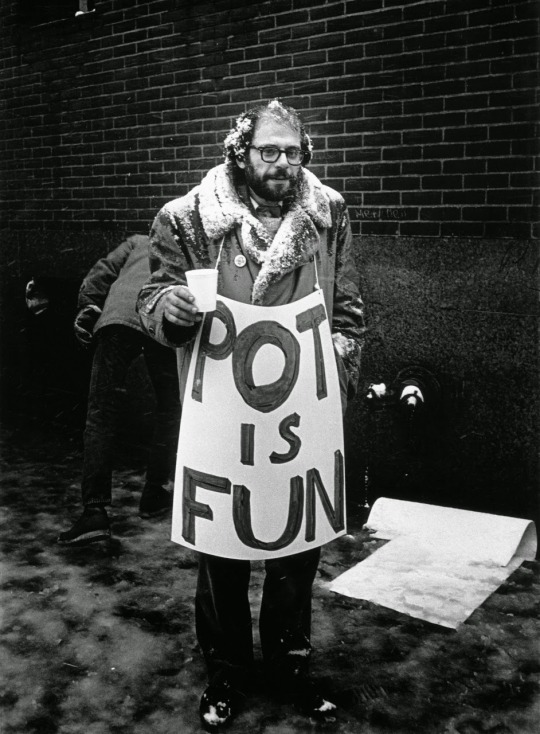
Ginsberg was a key figure in the protests of the 1960s such as the Vietnam protests in Berkeley, the National Democratic Conference in Chicago in 1968 during which he lead a crowd of 10,000 people in mantra chanting to try and get them to chill their beans, he was a key speaker at the Human Be-In in Golden Gate Park (that was the event where acid tabs were handed out freely to the crowd, Timothy Leary uttered his famous phrase ‘tune in, turn on, drop out’, and Ginsberg lead the crowd in more mantras and Buddhist music and poetry). So he was not just a poet. He was FOUNDING FATHER OF THE HIPPIES. The hippie OG. The hippie parent. The hippie guru. He was a hippie before hippies were a thing. Ginsberg was not just Buddhist, he was a hippie Buddhist. He took drugs, had orgies, and was a guru to the countercultural movement and his followers. Sound familiar? This is the dialogue between Dean and Cas in The End;
‘What’s with the drugs, the orgies, the love guru crap?’ (Dean to Cas)
‘What are you a hippie?’ (Dean to Cas)
‘What? Are you stoned?’ ‘Generally, yeh.’
‘In this way you will reach a fragment of total perception. Just one compartment in that dragonfly eye of group mind. Now, the key to this total shared perception is… it’s surprisingly physical… Why not get washed up for the orgie.’
(Cas to the group of women in The End). This speech could have been something Ginsberg would have said. In his essay ‘Dialectics of Liberation: 27th July 1967’ he declared that everyone should ‘have a unitive experience’, ‘an experience of One, of all of us being one’ (Dialectics of Liberation, 7-8).

So Cas is not just seen within this episode as having Buddhist leanings, more accurately, the Buddhist symbols that surround him are important within themselves but also act as a signifier to the other clues about who he is. He is a orgy loving, Buddhist, drug taking, love guru, pot smoking hippie. When Ginsberg first encountered the beats including Neal Cassady (aka Dean Moriarty), he was straight edge, Jewish, bookish. But by the 1960s he was a drug taking, sex loving hippie (although please don’t take this to mean that by the 1960s he was some sort of ruinous character, rather that he had loosened up a great amount on how wild a life he was living). So both Cas and Ginsberg go through these arcs. And if Cas is being shown to be a Buddhist hippie? Ginsberg is the original hippie.
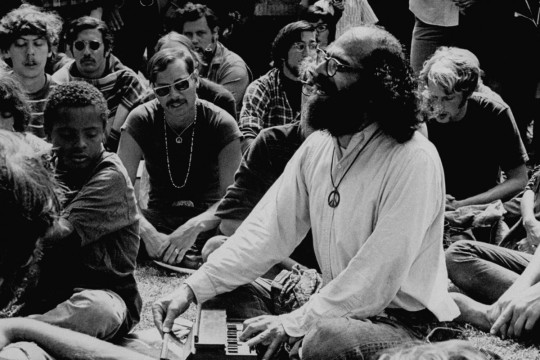
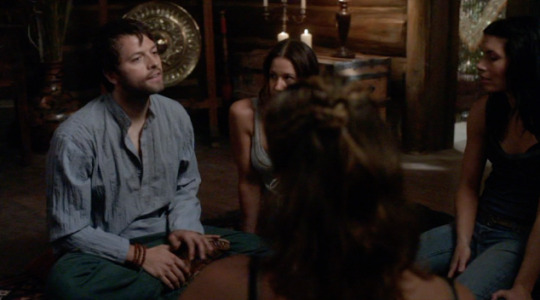
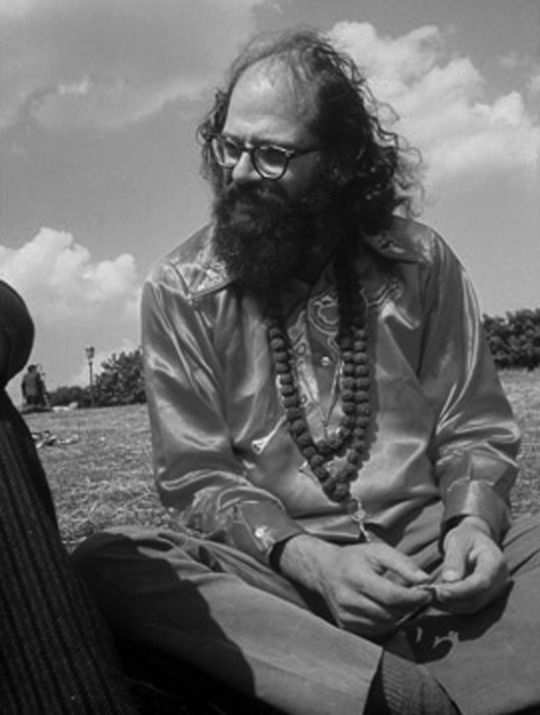
Cas is also styled like Ginsberg from the 1960s. After his trip to India in 1962, Ginsberg returned and dressed in cotton Indian clothes, and images of him wearing these clothes circulated and became a mainstay of hippie style.
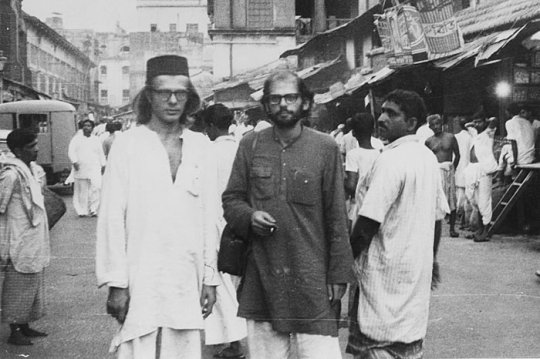
(Peter Orlovsky and Allen in India in 1962)
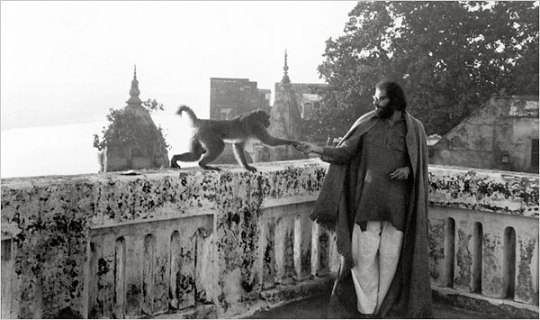
(Ginsberg in India in 1962)
Camp Chitaqua
There’s also something to be said about the Camp Chitaqua in The End. I don’t know if anyone has written about this, but its namesake seems to be Camp Chatauqua (on the Wikipedia page it shows a promotional brochure for the 1917 Cam, by CASS lake… mmmhmmm).

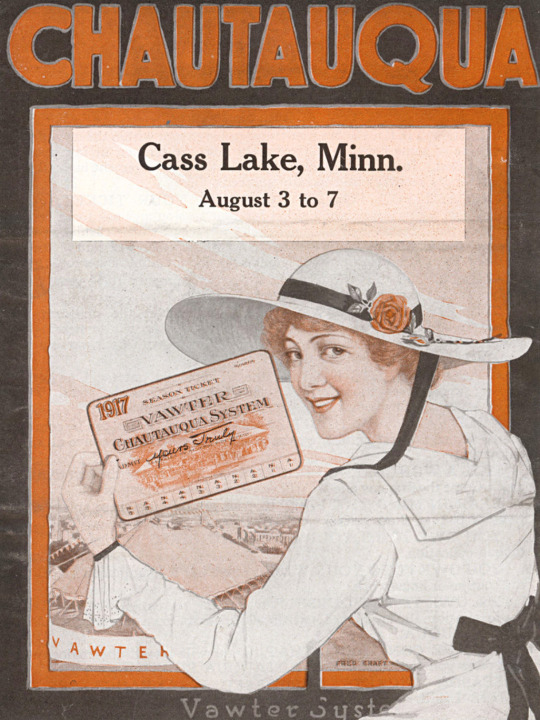
So Cam Chatauqua was an adult educational movement popular in the late 19th and early 20th centuries in rural America. It brought entertainment and culture to communities with speakers, teachers, musicians, entertainers, preachers, and specialists of the day. They were fairly Christian events, with Christian lectures occurring at each camp. Interestingly, some people have noted that the teach-ins during the 1960s protests were a successor of these camps. I say this is interesting because the 1960s protests were lead by either the New Left or the Hippies (or both, as they overlap a lot), and so lots of hippie gatherings and protests had Camp Chatauqua style lectures. One that I remember in particular was the 1964 Free Speech Movement protest on Berkeley Campus where they sat in the corridors of one of the main administration buildings and students gave lectures on politics or general things until they all got dragged out by police, beaten, and arrested. Anyway, these camps were influential to the protest tactics of the hippies – just something to note seeing as we’re discussing hippies at this point.
Neal Cassady (Dean Moriarty) and Allen Ginsberg
I covered this kind of in my post about SPN and On The Road. So Neal Cassady became friends with Ginsberg during the 1940s whilst Ginsberg was at Columbia University. Ginsberg fell in love with him and they had sex and continued to have sex on and off until at least the mid-1950s, but remained great friends until Neal’s death in 1966. Neal denied any homosexual leanings to many people within his life, had many girlfriends and a few wives. But Ginsberg and Cassady made vows to each other to love each other, and they were very close, but ultimately Neal didn’t want to be Allen’s partner and their sexual relationship ended some time before his death. Allen spent most of his life with his long-time partner Peter Orlovsky and their relationship was fraught and incredibly complex but that’s another story for another time.
But seeing as Dean Winchester and Neal Cassady are similar, and seeing how (if we’re looking for who from the Beat Canon Cas is) Ginsberg is similar to Cas, the fact that Neal and Allen were in a relationship (of sorts) can be transferred to Dean and Cas.
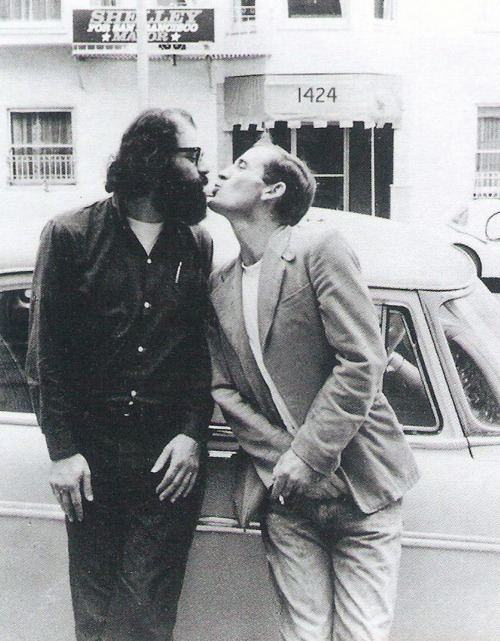
(Allen and Neal)
Conclusion
OK, so these are my starting thoughts on this discussion. I think the main thing I realised whilst rewatching The End wasn’t the Buddhism (which is why I watched it to begin with). Rather it was how Buddhism was used as a signifier of Cas’s hippieness, or how Cas uses sex, drugs, and Buddhism, and discusses consciousness and how all of this speaks to him as a Ginsberg-like figure.
I will continue discussing Ginsberg within these posts but I’m next going to focus specifically on Cas and Buddhism on my next post! Feel free to ask any questions about this and I will continue going over all my academic books and notes and add more to these discussions :)
#Cas x Ginsberg#supernatural and the beats#my supernatural discourse#supernatural meta#cas meta#human!cas#the end#supernatural season 5#season 5 meta#castiel#cas#cas x buddhism#cas x spirituality#cas x ginsberg x buddhism#supernatural discourse
139 notes
·
View notes
Video
youtube

write my essay
About me
Can You Help Me Proof My Essay?
Can You Help Me Proof My Essay? Launched in October 2010, we started with the mission of serving to students create excellent citations in a fraction of the time. Since then, Cite This For Me has assisted tens of millions of users internationally together with within the United Kingdom, United States, Australia, and past. Twitter customers, who included people claiming to know Krug, have theories — along with reactions to the information. Wayne Arthurson is a author of Cree and French Canadian descent. By now, all however those in deepest denial or hiding within the dimmest ideological corners understand that, because the creator describes, “we are already contained in the apocalypse”. But by selecting to act, to “march and cry and mourn and sing and hope and struggle for the world”, she argues that we are able to envision a future with us in it. Once you have accomplished your bibliography or reference listing, it’s time to export it! The New Old Age will run as a twice-monthly column by Paula Span on nytimes.com and incessantly in Science Times. South Korea outbreak, China crackdown, Aleksei Navalny Heres what you should know. Some college districts and faculties also had outages on Canvas, an online studying platform. Office for National Statistics information shows that the variety of individuals dying of Covid-19 each week in England and Wales has nonetheless been falling constantly since April. Made me go through my paper and alter everytime i did it. Macdonald isn't, nonetheless, given to sounding dire, all-caps warnings. Its a part of rising up, testing limits and adjusting to social expectations and norms. The Russell Crowe thriller introduced in $4 million domestically a figure that might usually disappoint but, given the pandemic, is seen as a hit. The blog is ending, however our coverage of caregiving and getting older is not. They host a monthly ritual space for bizarre, rad Jews and their associates. They can be discovered cooking dinner for 20 or making zines about magic. Miriam a Jewish Currents Fellow for the 2020 New Voices Fellowship 12 months. It’s unclear why Krug determined to write down and publish her essay. You can copy and paste your citations from Cite This For Me into your paper, project, or document. If you’re trying to export it as a Word Doc, our premium features were designed for you. Formal citing accomplished for papers and tasks takes this a step further. In addition to the reasons talked about above, citing sources in academia offers proof of your research course of and helps you avoid plagiarism. Cite This For Me is likely one of the most popular quotation tools at present. Add citations immediately into your paper, Check for unintentional plagiarism and examine for writing mistakes. Join hundreds of students and fogeys getting exclusive highschool, take a look at prep, and faculty admissions info. Our associates on the time thought she was somewhat loopy to throw out a totally drafted essay in favor of a new subject, however we quickly realized that there was technique to her insanity. The Red Chesterfield won the 2020 Arthur Ellis Award for finest crime novella. Lots of academics don't need contractions in essays anyway. I thought u weren't supposed to make use of conjunctions in any case? Well thats what one writing coach said at my school. The youngster floated half a mile away from the city of Antirrio, Greece, within the Gulf of Corith where she was enjoying in the water along with her parents on Sunday. The desolatebeauty of the winemaking custom on Lanzarote, the easternmost of the Canary Islands, is proof of human resilience in the face of adversity. Miriam Saperstein is a writer and combined media artist, initially from Metro Detroit. They are a junior on the University of Michigan, where they ask plenty of questions about Jewish histories, and the way to construct accountable, supportive communities.
0 notes
Photo

Feast of the Holy Innocents - Martyrs - December 28th - Both Calendars
O God, Whose praise the martyred innocents did this day proclaim, not by speaking, but by dying: Destroy in us all the malice of sinfulness, that our lives may also proclaim thy faith, which our tongues profess. Through our Lord. Amen.
***
During the octave of Christmas, the church celebrates the memory of the small children of the neighborhood of Bethlehem who were put to death by Herod. These innocent lives bear witness to Christ who was persecuted from the time of His birth by a world which would not receive Him. It is Christ Himself who is at stake in this mass-murder of the children; already the choice, for or against Him, is put clearly before men. But the persecutors are powerless, for Christ came to perform a work of salvation that nothing could prevent; when He fell into the hands of His enemies at the time chosen by God, it was to redeem the world by His own blood. Our Christmas joy is tempered on this day by a feeling of sadness. But the church looks principally to the glory of the children, of these innocent victims, whom she shows us in heaven following the Lamb wherever he goes.
***
The Holy Innocents (AKA Childermas) are called such for three reasons. First, by cause and reason of life; Second, by reason of pain; and Third, by reason of innocence. They are innocent by reason of life because they had an innocent life. They grieved nobody, neither God, by in obedience, nor their neighbors by untruth, nor by conceiving of any sin. It is said in the psalter that the innocents and righteous have joined them to me by their life and righteousness in the faith. They are innocent by reason of pain, for they suffered death innocently and wrongly, wherein David said: “They have shed the blood of innocents by reason of innocency.” In this martyrdom, they were baptized and made clean of the original sin, of which innocence is said in the psalter: “Keep thou innocency of baptism and see equity of good works.” This is the third reason for their innocents.
***
The Massacre of the Holy Innocents is recorded in the second Chapter of the Book of Matthew. It recalls an event when Pharaoh instructed the midwives during the time Israel was enslaved in Egypt: “And the king of Egypt spoke to the midwives of the Hebrews of whom was called Sephora, the other Phua, commanding them: when you shall do the office of midwives to the Hebrew women, and the time of delivery is come: if it be a man child, kill it: if a woman, keep it alive...Pharaoh therefore charged all his people, saying: Whatsoever shall be born of the male sex, ye shall cast into the river: whatsoever of the female, ye shall save alive . (Exodus 1:15-16, 22)
Moses was saved from this murder when his mother placed him in a little ark and floated him in the river. Moses' sister watched from afar as the Pharaoh’s daughter found the child (Exodus 2). The massacre from which Moses was spared is a type, a foreshadowing, of the massacre of the holy innocents that took place soon after Christ was born.
***
In the Gospel of St. Matthew (2: 16-18) we read: “Herod perceiving that he was deluded by the wise men, was exceedingly angry; and sending soldiers, killed all the men children that were in Bethlehem, and in all the borders thereof, from two yeas old and under, according to the time which he had diligently inquired of the wise men. Then was fulfilled that which was spoken by Jeremiah the prophet, saying: A voice in Rama was heard, lamentation and great mourning; Rachel bewailing her children, and would not be comforted, because they are not.”
***
In order to understand which Herod it was that so cruelly put so many children to death, we must first understand that there were three Herod's. All three were cruel tyrants, and in their time of great fame, were known for their great malice.
The first was Herod Ascalonita, he reigned in Jerusalem when our Lord was born. The second was Herod Antipas, to whom Pilate sent Jesus Christ in the time of His passion, and who also beheaded Saint John The Baptist. The third was Herod Agrippa, who beheaded Saint James . (The first Apostle to be martyred) and sent Saint Peter to prison.
It was Herod Ascalonita, the first Herod, who killed the innocents. He had served the Roman emperor Julian with such great distinction, that Julian gave him the realm of Jerusalem to rule. This resulted in the Jewish kings losing their lineage, and fulfilled the prophecy of the birth of our Lord.
When the three Magi's came to Jerusalem seeking the king of the Jews that had just been born, Herod had a great dread, fearing that anyone born of the true lineage of the kings of the Jews, and being a true heir, would chase him out of his realm. He demanded to know from the three Magi's how they had knowledge of this new king. They answered by a star being in the air, which was not naturally fixed in the heaven as were the others. He then asked the magi's to return after they had worshiped the new king, so that he might also go and worship the child.
After the three magi's departed without bringing him any news, he decided to slay all the newborn children in Bethlehem and its surroundings. He could not immediately carry out his plan, because the emperor sent him a citation to come to Rome to answer accusations by his sons. He spent more than a half a year traveling to and from Rome to answer the accusations, meanwhile, Jesus was on his way to Egypt.
When Herod returned from Rome and feeling secure that the emperor had again confirmed his realm, he again decided to kill the children. Since more than a year had passed since the three magi's went to see him, he decided to slay all the children that were of the age of two years.
***
REFLECTION
That the Holy Innocents may be invoked to be preserved from illusion is the Church’s belief. Herod’s illusion of threat from the newborn King cost their lives...How few, perhaps, of these innocent little ones, if they had lived, would have escaped the dangers of the world. From what snares, what sins, what miseries were they preserved. Surely they rejoice now in their fate. We often lament, as misfortunes, many accidents which in the designs of Heaven are the greatest mercies.
***
Blessing of Children on Holy Innocents Day
The feast of the Holy Innocents is a good time to teach the children about their special patrons. There is also a traditional children’s blessing for the feast of the Holy Innocents that can be performed by the parents in the absence of a priest’s blessing at church.
The father leads everyone present in the Our Father. Then he says the vesicles, “O Lord, hear my prayer,” and all respond, “And let my cry come unto You. The father proceeds with this prayer taken from the blessing for children:
Let us pray. O Lord Jesus Christ, once You embraced and placed Your hands upon the little children who came to You, and said: “Suffer the little children to come unto Me, and forbid them not, for theirs is the kingdom of heaven, and their angels always see the face of my Father!” Look now with fatherly eyes on the innocence of these children and their parents’ devotion, and bless them this day through our ministry. (The father signs the forehead of each child with the sign of the cross.) In Your grace and goodness let them advance continually, longing for You, loving You, fearing You, keeping Your commandments. Then they will surely come to their destined home, through You, Savior of the world. Who lives and reigns forever and ever.
All answer: Amen.
Then the father says to the children: “May God bless you. And may He keep your hearts and minds - the Father, Son and the Holy Ghost.”
All answer: Amen.
The father then sprinkles the children with holy water.
(The Church’s official blessing of children is included in the Roman Ritual.)
Prayer source: Twelve Days of Christmas, The by Elsa Chaney, The Liturgical Press, Collegeville, MN, 1955.
1 note
·
View note
Text
was wondering why it’d been so surprising to me that kennedy & davis’s methodology (treating oral histories as historical documents & performing thematic analysis accordingly) was considered revolutionary in the academy (after publication so we’re talking mid-90s at the earliest) when i couldn’t conceptualize of what acting otherwise would even look like
and then i realized it’s because my introduction to sociological research was through conducting semi-structured oral history interviews with longtime local [in scale, not to me] activists, by way of a leftist engineer, so like, of course this is data and you code it.
& it’s so fascinating to think like… maybe the impact of this research methodology (which is itself owed to Indigenous knowledges, as they credit) unbeknownst to him rippled to affect my late mentor who then taught me. like there are definitely some weirdos (beloved) in environmental engineering who could be super into butch/fem &/or lesbian history or have a (even small) background in gender studies that was influenced by this & similar work
3 notes
·
View notes
Photo

Platypus Press, 2017, $13.00 http://platypuspress.co.uk/mannishtongues
By Allison Bird Treacy
When we seek to magnify voices – of an individual, of a group – how do we go about it? According to Nick Cave’s 2011 installation, “Speak Louder,” the answer rests in the body. Silver spangled and forcefully resonant, Cave’s suits are sculptures, costumes, and instruments all at once, and rooted in ritual. And as the inspiration for Jayy Dodd’s poem by the same name, nearly everything that can be said of Cave’s “Speak Louder” can also be said of Dodd’s 2017 collection, Mannish Tongues. At its core, Mannish Tongues celebrates, mourns, and does this all while garbed in silver, demanding our attention.
Dodd’s Mannish Tongues contains prayerful, and riotous poems. Opening with epigraphs by Essex Hemphill and the Book of Proverbs and anchored by an array of core figures, including Tamir Rice, the artist Nick Cave, and Rodney King, Dodd’s poems are a liturgy of blackness, queerness, and boyness. In Dodd’s words:
if i fix my lips to speak themselves free, allow my voice to break in riot,
be vocabulary barreling through a nation’s mourning, be vernacular of bullets coming for the back of your throat. (from “Eloquent”)
A force to be reckoned with, these poems are necessary for our present moment.
In the church of Dodd’s poems, resurrection is a recurring theme. Because the Black body and the queer body are both continually subject to death, resurrection is a necessary part of their construction. After each death, one must return to the page and the poem. For Dodd’s speaker, this notion is instilled early in life by the mother, who is parent, preacher, and God in one. In “There’s Something Bout Being Raised In Church” Dodd writes,
i first learned fear as my mothers’ eyes, when i would act my age in the front row & that death was always subject to some sort of resurrection —
The constant fear of death that plagues the mothers of black sons is presented as inescapable repetition. It’s the oppression of living with the “end times/as regular occurrence” as the speaker in “Returning” notes. But returning and resurrection, they share a suffix, the “re-” of repetition, the again and again that makes up any liturgy or rosary. Repetition is holy, as Nikky Finney once said and Dodd words play this out with every death, in each historical citation. It all comes back around.
Dodd meditates on the concept of the infinite monkey in their poem by the same name, though, the black body makes up this infinite populace. The infinite monkeys become
infinite Harambes infinite African bodies displaced infinite cages infinite Black mothers wailing in daylight for safe return
The list goes on. In the eyes of white society there is slippage between infinite monkeys of all stripes and “infinite Barack Obamas bopping out The Audacity of Hope.” The black body and the monkey’s body switch and fold into and over each other and the reader remembers how sympathy for Harambe, who holds space for this poem, exceeded any sympathy for actual black people facing needless death. And so the wailing goes on.
Dodd’s poems are rich in history, on poetic tradition as embodied in their “ars poetica” or “scene: waking up next to John Keats after a pleasant evening” and yet they balance all of their traditional art with vulnerability and transgression. Dodd dares us to come closer, to stand too close to choir boys (or girls), to unearth our own desire in the work. If it’s all been done before or could be done by infinite or immortal monkeys, in Mannish Tongues history is resurrected as the present with a new face, daring us to linger with this
#jayy dodd#allison bird treacy#mannish tongues#platypus press#poetry books#poetry reviews#national poetry month
0 notes
Text
Research for Gong Building
Traditional suspended gongs:
Chau gong (Tam-tam)
The familiar "Chinese" gong (a 10-inch (25 cm) chau gong)
By far the most familiar to most Westerners is the chau gong or bullseye gong. Large chau gongs, called tam-tams (not to be confused with tom-tom drums) have become part of the symphony orchestra. Sometimes a chau gong is referred to as a Chinese gong, but in fact it is only one of many types of suspended gongs that are associated with China.
A chau gong is made of copper-based alloy, bronze or brass. It is almost flat except for the rim, which is turned up to make a shallow cylinder. On a 10-inch (25 cm) gong, for example, the rim extends about 1⁄2 inch (1 cm) perpendicular to the gong surface. The main surface is slightly concave when viewed from the direction to which the rim is turned. The centre spot and the rim of a chau gong are left coated on both sides with the black copper oxide that forms during the manufacture of the gong, the rest of the gong is polished to remove this coating. Chau gongs range in size from 7 to 80 inches (18 to 203 cm) in diameter.
The earliest Chau gong is from a tomb discovered at the Guixian site in the Guangxi Zhuang Autonomous Region of China. It dates from the early Western Han Dynasty. They were known for their very intense and spiritual drumming in rituals and tribal meetings.[citation needed]
Traditionally, chau gongs were used to clear the way for important officials and processions, much like a police siren today. Sometimes the number of strokes on the gong was used to indicate the seniority of the official. In this way, two officials meeting unexpectedly on the road would know before the meeting which of them should bow down before the other.
Uses of gongs in the symphony orchestra
The tam-tam was first introduced as an orchestral instrument by François-Joseph Gossec in 1790, and it was also taken up by Gaspare Spontini and Jean-François Le Sueur.[2] Hector Berlioz deployed the instrument throughout his compositional career, and in his Treatise on Instrumentation he recommended its use "for scenes of mourning, or for the dramatic depiction of extreme horror."[2] Other composers who adopted the tam-tam in the opera house included Gioachino Rossini, Vincenzo Bellini and Richard Wagner;[3] Rossini in the final of act 3 of Armida (1817),[4] Bellini in Norma (1831) and Wagner in Rienzi (1842). Within a few decades the tam-tam became an important member of the percussion section of a modern symphony orchestra. It figures prominently in the symphonies of Peter Ilyich Tchaikovsky,[5] Gustav Mahler,[6] Dmitri Shostakovich[7] and, to a lesser extent, Sergei Rachmaninov and Sergei Prokofiev. Giacomo Puccini used both gongs and tam-tams in his operas. Igor Stravinsky greatly expanded the playing techniques of the tam-tam in his The Rite Of Spring to include short, quickly damped notes, quick crescendos, and a triangle beater scraped across the front of the instrument. Karlheinz Stockhausen used a 60" Paiste tam-tam in his Momente.
Material for gongs: Gongs are usually made out of brass, copper, bronze or these material mixture with silver. Pretty decent gong could be made out of iron (steel) a well. Some amazing gong making examples:
youtube
youtube
0 notes
Text
tired of sitting with my grief & mothering it, but don’t want to orphan it either, or play absent father to the howl along my bones. wanna take it to the river & stay under long enough to get both our hair wet & come up triumphant, clinging to each other as we gasp. wanna buy it a milkshake & drive too fast. wanna older-brother it, shelter & silence both, an eventual distance but always a circling back, a coming home.
50 notes
·
View notes
Text
what’s the etiquette on posthumous publications? could your partner bear to see your CV outlive you? could we bear not to declare it’s still yours? i wasn’t exaggerating when i said i still edit in your voice—got a dozen places to go back & specify it’s a positive impact. know anybody i ever teach will feel the shape of this grief, a six-two silhouette rereading every paragraph.
7 notes
·
View notes